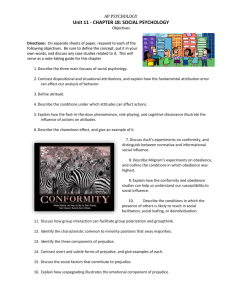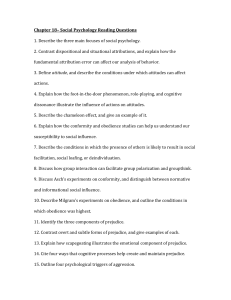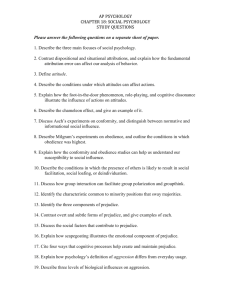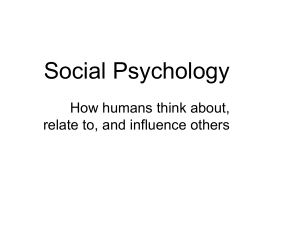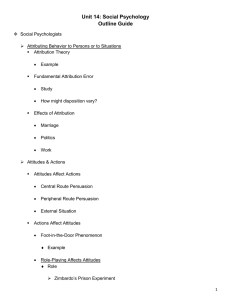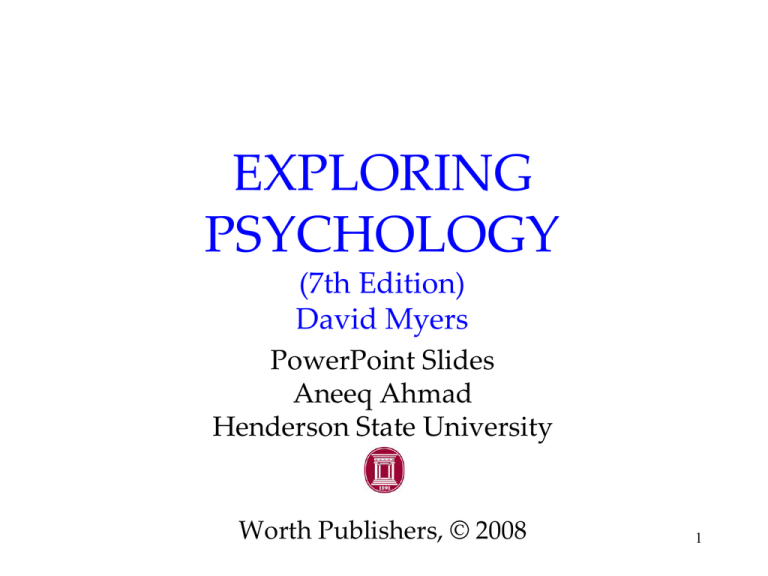
EXPLORING
PSYCHOLOGY
(7th Edition)
David Myers
PowerPoint Slides
Aneeq Ahmad
Henderson State University
Worth Publishers, © 2008
1
Social Psychology
Chapter 15
2
Focuses in Social Psychology
“We cannot live for ourselves alone.”
Herman Melville
Social psychology scientifically studies how we
think about, influence, and relate to one another.
3
THE POWER OF THE
SITUATION VIDEO
The main idea of the following experiments:
–
–
–
–
–
Lewin: leadership style
Asch: conformity
Milgram: obedience to authority
Zimbardo: social roles
Moriarty: altruistic (helping behavior)
4
Effects of Attribution
How we explain someone’s behavior affects
how we react to it.
5
Attitudes & Actions
A belief and feeling that predisposes a person
to respond in a particular way to objects, other
people, and events.
If we believe a person is mean, we may feel
dislike for the person and act in an unfriendly
manner. Cognitive, affective, and behavioral
components.
6
Attitudes Can Affect Actions
Our attitudes predict our behaviors imperfectly
because other factors, including the external
situation, also influence behavior.
Democratic leaders supported Bush’s attack on
Iraq under public pressure. However, they had
their private reservations.
7
Attitudes
• Think of a time when you became angry.
Describe why you became angry in a few
sentences.
• Think of a time when someone else became
angry. Describe why this person became
angry in a few sentences.
8
Attitudes
• Share your examples with a partner.
• Determine: Was it the situation or the
person’s characteristics that caused the
anger?
• Class average:
9
Fundamental Attribution Error
The tendency to overestimate the impact of
personal disposition and underestimate the
impact of the situations in analyzing the
behaviors of others leads to the fundamental
attribution error.
Example?
10
Actions Can Affect Attitudes
Not only do people stand for what they believe in
(attitude), they start believing in what they stand
for.
D. MacDonald/ PhotoEdit
Cooperative actions can lead to mutual liking (beliefs).
11
Role Playing Affects Attitudes
Zimbardo (1972) assigned the roles of guards
and prisoners to random students and found
that guards and prisoners developed roleappropriate attitudes.
Originally published in the New Yorker
Phillip G. Zimbardo, Inc.
12
Actions Can Affect Attitudes
Why do actions affect attitudes? One
explanation is that when our attitudes and
actions are opposed, we experience tension.
This is called cognitive dissonance.
To relieve ourselves of this tension we bring our
attitudes closer to our actions (Festinger, 1957).
13
Cognitive Dissonance
14
Social Influence
The greatest contribution of social psychology is
its study of attitudes, beliefs, decisions, and
actions and the way they are molded by social
influence.
NON SEQUITER © 2000 Wiley. Dist. by Universal
Press Syndicate Reprinted with Permission
15
Conformity & Obedience
Behavior is contagious, modeled by one
followed by another. We follow behavior of
others to conform.
Other behaviors may be an expression of
compliance (obedience) toward authority.
Conformity
Obedience
16
The Chameleon Effect
Conformity: Adjusting one’s behavior or
thinking to coincide with a group standard
(Chartrand & Bargh, 1999).
17
Group Pressure & Conformity
Suggestibility is a subtle type of conformity,
adjusting our behavior or thinking toward
some group standard. Asch line experiment.
18
Group Pressure & Conformity
An influence resulting from one’s willingness to
accept others’ opinions about reality. Asch line
experiment.
William Vandivert/ Scientific American
19
Conditions that Strengthen
Conformity
1.
2.
3.
4.
5.
6.
7.
One is made to feel incompetent or insecure.
The group has at least three people.
The group is unanimous.
One admires the group’s status and
attractiveness.
One has no prior commitment to a response.
The group observes one’s behavior.
One’s culture strongly encourages respect for a
social standard.
20
Obedience
Stanley Milgram
designed a study that
investigates the effects of
authority on obedience.
Courtesy of CUNY Graduate School and University Center
People comply to social
pressures. How would
they respond to outright
command?
Stanley Milgram
(1933-1984)
21
Both Photos: © 1965 By Stanley Miligram, from the
film Obedience, dist. by Penn State, Media Sales
Milgram’s Study
22
Milgram’s Study: Results
23
Individual Resistance
A third of the individuals in Milgram’s study
resisted social coercion.
AP/ Wide World Photos
An unarmed individual single-handedly
challenged a line of tanks at Tiananmen Square.
24
Lessons from the Conformity and
Obedience Studies
In both Asch's and Milgram's studies,
participants were pressured to choose between
following their standards and being responsive
to others.
In Milgram’s study, participants were torn
between hearing the victims’ pleas and the
experimenter’s orders.
25
Group Influence
How do groups affect our behavior? Social
psychologists study various groups:
1.
2.
3.
4.
One person affecting another
Families
Teams
Committees
26
Social Loafing
The tendency of an individual in a group to
exert less effort toward attaining a common
goal than when tested individually (Latané,
1981).
27
Deindividuation
The loss of self-awareness and self-restraint in
group situations that foster arousal and
anonymity.
Mob behavior
28
Social Relations
Social psychology teaches us how we relate to
one another through prejudice, aggression, and
conflict to attraction, and altruism and
peacemaking.
29
Reign of Prejudice
Prejudice works at the conscious and [more at]
the unconscious level.
Therefore, prejudice is more like a knee-jerk
response than a conscious decision.
30
Prejudice
Simply called “prejudgment,” a prejudice is an
unjustifiable (usually negative) attitude toward
a group and its members. Prejudice is often
directed towards different cultural, ethnic, or
gender groups.
Components of Prejudice:
1. Beliefs (stereotypes)
2. Emotions (hostility, envy, fear)
3. Predisposition to act (to discriminate)
31
Cognitive Roots of Prejudice
One way we simplify our world is to categorize.
We categorize people into groups by
stereotyping them.
Michael S. Yamashita/ Woodfin Camp Associates
Foreign sunbathers may think Balinese look alike.
32
CATEGORIES AND
PROTYPES
We have a tendency to use prototypes
(most typical example) in our thinking
We assign people to those categories and
then assume they are like the prototype.
EXAMPLE?
33
Cognitive Roots of Prejudice
In vivid cases such as the 9/11 attacks, terrorists
can feed stereotypes or prejudices (terrorism).
Most terrorists are non-Muslims.
34
Cognitive Roots of Prejudice
© The New Yorker Collection, 1981, Robert Mankoff from cartoonbank.com. All Rights Reserved.
The tendency of people to believe the world is
just, and people get what they deserve and
deserve what they get (the just-world
phenomenon).
35
Gender
Although prejudice prevails against women, more people
feel positively toward women than men. Women rated
picture b [feminized] higher (66%) for a matrimonial ad
(Perrett & others, 1998).
Professor Dave Perrett, St. Andrews University
36
Social Roots of Prejudice
Why does prejudice arise?
1. Social Inequalities
2. Social Divisions
3. Emotional Scapegoating
define
37
Social Inequality
Prejudice develops when people have money, power,
and prestige, and others do not. Social inequality
increases prejudice.
View the videotape of the Green Eyed and Blue Eyed
Experiment. Remember the time period when the
experiment was first conducted. Look for examples of:
Social inequality
Ingroup bias
Scapegoating
38
Us and Them
Ingroup: People with whom one shares a
common identity. Outgroup: Those perceived as
different from one’s ingroup. Ingroup Bias: The
tendency to favor one’s own group.
Mike Hewitt/ Getty Images
Scotland’s famed “Tartan Army” fans.
39
Emotional Roots of Prejudice
Prejudice provides an outlet for anger [emotion]
by providing someone to blame. After 9/11
many people lashed out against innocent
Arab-Americans. This is called scapegoating.
40
Hindsight Bias
After learning an outcome, the tendency to
believe that we could have predicted it
beforehand may contribute to blaming the
victim and forming a prejudice against them.
41
The Psychology of Attraction
1. Proximity: Geographic nearness is a powerful
predictor of friendship. Repeated exposure to
novel stimuli increases their attraction (mere
exposure effect). Example?
Rex USA
A rare white penguin born
in a zoo was accepted after
3 weeks by other penguins
just due to proximity.
42
Psychology of Attraction
2. Physical Attractiveness: Once proximity
affords contact, the next most important thing
in attraction is physical appearance.
Brooks Kraft/ Corbis
Brooks Kraft/ Corbis
43
Psychology of Attraction
• Halo Effect: attractive people are assumed
to possess positive traits that have nothing
to do with physical attributes. Examples?
• Matching Hypothesis of Attraction:
– Activity
– Definition: people of equal attractiveness tend
to form interpersonal bonds
44
Psychology of Attraction
3. Similarity: Similar views among individuals
causes the bond of attraction to strengthen.
Similarity breeds content!
45
RELATIONSHIPS
Factors Promoting Long Term Relationships:
Equity: A condition in which people
receive from a relationship in proportion
to what they give.
Self-Disclosure: Revealing intimate
aspects of oneself to others.
46
ALTRUISM
• DEFINITION: The unselfish regard for the
welfare of others.
• Darley and Latane first studied the case of
Kitty Genovese.
47
Bystander Intervention
The decision-making process for bystander
intervention.
Akos Szilvasi/ Stock, Boston
48
Bystander Effect
Tendency of any given
bystander to be less likely
to give aid if other
bystanders are present.
Diffusion of Responsibility:
Our tendency to pass on
the responsibility for action
to others. It’s the cause of
the bystander effect.
49
REVIEW ASSIGNMENT
Highlight the following terms:
•
•
•
•
•
•
•
•
One: naturalistic observation, correlation coefficient
Two: neurotransmitters, corpus callosum
Five: retinal disparity, tympanic membrane
Twelve: free association, Rorschach
Seven: generalization, negative reinforcement
Thirteen: obsession, schizophrenia
Fifteen: altruism, matching hypothesis
Four: egocentrism, secure attachment
FINAL EXAM REVIEW
• CHOOSE ONE OF THE FOLLOWING
METHODS TO REVIEW:
– Use your own final exam review sheet
assignment
– Skim the chapter power points (see my web
page)
– Take practice tests from the relevant chapters
(use study guide or textbook web site, access
from my web page)
51

